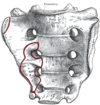
Sacral spinal nerve 1
Encyclopedia
The sacral spinal nerve 1 (S1) is a spinal nerve
of the sacral segment..
It originates from the spinal column from below the 1st body of the sacrum

Spinal nerve
The term spinal nerve generally refers to a mixed spinal nerve, which carries motor, sensory, and autonomic signals between the spinal cord and the body...
of the sacral segment..
It originates from the spinal column from below the 1st body of the sacrum
Sacrum
In vertebrate anatomy the sacrum is a large, triangular bone at the base of the spine and at the upper and back part of the pelvic cavity, where it is inserted like a wedge between the two hip bones. Its upper part connects with the last lumbar vertebra, and bottom part with the coccyx...

Muscles
S1 supplies many muscles, either directly or through nerves originating from S1. They are not innervated with S1 as single origin, but partly by S1 and partly by other spinal nerves. The muscles are:- gluteus maximus muscleGluteus maximus muscleThe gluteus maximus is the largest and most superficial of the three gluteal muscles...
- gluteus medius muscleGluteus medius muscleThe gluteus medius , one of the three gluteal muscles, is a broad, thick, radiating muscle, situated on the outer surface of the pelvis....
- gluteus minimus muscleGluteus minimus muscleThe gluteus minimus , the smallest of the three gluteal muscles, is situated immediately beneath the gluteus medius.-Origin and insertion:...
- tensor fasciae lataeTensor fasciae lataeThe tensor fasciae latae or tensor fasciæ latæ is a muscle of the thigh. The English name for this muscle is the muscle that stretches the band on the side...
- piriformisPiriformis muscleThe piriformis is a muscle in the gluteal region of the lower limb. It was first named by Spigelius, a professor from the University of Padua in the 16th century.- Origin and insertion :...
- obturator internus muscleObturator internus muscleThe obturator internus muscle originates on the medial surface of the obturator membrane, the ischium near the membrane, and the rim of the pubis.It exits the pelvic cavity through the lesser sciatic foramen....
- inferior gemellusInferior gemellus muscleThe inferior gemellus muscle is a muscle of the human body.The Gemelli are two small muscular fasciculi, accessories to the tendon of the Obturator internus which is received into a groove between them....
- superior gemellusSuperior gemellus muscleThe superior gemellus muscle is a muscle of the human body.The Gemelli are two small muscular fasciculi, accessories to the tendon of the Obturator internus which is received into a groove between them....
- quadratus femorisQuadratus femoris muscleThe quadratus femoris is a flat, quadrilateral skeletal muscle. Located on the posterior side of the hip joint, it is a strong external rotator and adductor of the thigh, but also acts to stabilize the femoral head in the Acetabulum.- Course :...
- semitendinosusSemitendinosus muscleThe semitendinosus is a muscle in the back of the thigh; it is one of the hamstrings.-Structure:The semitendinosus, remarkable for the great length of its tendon of insertion, is situated at the posterior and medial aspect of the thigh ....
- gastrocnemiusGastrocnemius muscleIn humans, the gastrocnemius muscle is a very powerful superficial pennate muscle that is in the back part of the lower leg. It runs from its two heads just above the knee to the heel, and is involved in standing, walking, running and jumping. Along with the soleus muscle it forms the calf muscle...
- flexor hallucis longusFlexor hallucis longus muscleThe Flexor hallucis longus muscle is a muscle of the leg.It is one of the deep muscles of the posterior compartment of the leg. The other deep muscles of the leg are flexor digitorum longus and tibialis posterior. Tibialis posterior is most powerful of these deep muscles.The Flexor hallucis...
- abductor digiti minimiAbductor digiti minimi muscle (foot)The Abductor digiti minimi is a muscle which lies along the lateral border of the foot, and is in relation by its medial margin with the lateral plantar vessels and nerves....
- quadratus plantaeQuadratus plantae muscleThe Quadratus plantæ is separated from the muscles of the first layer by the lateral plantar vessels and nerve. It acts to aid in flexing the 2nd to 5th toes and is one of the few muscles in the foot with no homolog in the hand.It arises by two heads, which are separated from each other by the long...

